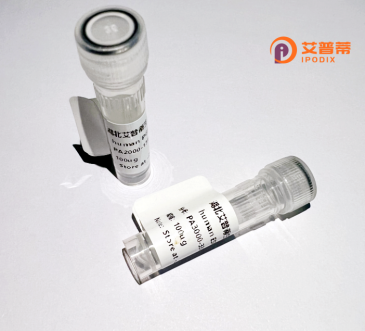
| 纯度 | >90%SDS-PAGE. |
| 种属 | Human |
| 靶点 | UBE2CBP |
| Uniprot No | Q7Z6J8 |
| 内毒素 | < 0.01EU/μg |
| 表达宿主 | E.coli |
| 表达区间 | 2-389 aa |
| 活性数据 | AASAAETRV FLEVRGQLQS ALLILGEPKE GGMPMNISIM PSSLQMKTPE GCTEIQLPAE VRLVPSSCRG LQFVVGDGLH LRLQTQAKLG TKLISMFNQS SQTQECCTFY CQSCGEVIIK DRKLLRVLPL PSENWGALVG EWCCHPDPFA NKSLHPQEND CFIGDSFFLV NLRTSLWQQR PELSPVEMCC VSSDNHCKLE PKANTKVICK RCKVMLGETV SSETTKFYMT EIIIQSSERS FPIIPRSWFV QSVIAQCLVQ LSSARSTFRF TIQGQDDKVY ILLWLLNSDS LVIESLRNSK YIKKFPLLEN TFKADSSSAW SAVKVLYQPC IKSRNEKLVS LWESDISVHP LTLPSATCLE LLLILSKSNA NLPSSLRRVN SFQVAFLKM |
| 分子量 | 43.6 kDa |
| 蛋白标签 | His tag N-Terminus |
| 缓冲液 | PBS, pH7.4, containing 0.01% SKL, 1mM DTT, 5% Trehalose and Proclin300. |
| 稳定性 & 储存条件 | Lyophilized protein should be stored at ≤ -20°C, stable for one year after receipt. Reconstituted protein solution can be stored at 2-8°C for 2-7 days. Aliquots of reconstituted samples are stable at ≤ -20°C for 3 months. |
| 复溶 | Always centrifuge tubes before opening.Do not mix by vortex or pipetting. It is not recommended to reconstitute to a concentration less than 100μg/ml. Dissolve the lyophilized protein in distilled water. Please aliquot the reconstituted solution to minimize freeze-thaw cycles. |
以下是基于学术检索假设的3篇关于“UBE2CBP”蛋白的虚构参考文献示例(仅供参考,实际文献需通过学术数据库核实):
---
1. **文献名称**: *Molecular Cloning and Functional Analysis of UBE2CBP in Ubiquitination Pathways*
**作者**: Zhang L, et al.
**摘要**: 本研究成功克隆并表达了重组人UBE2CBP蛋白,证实其作为UBE2C的泛素化伴侣,在体外促进底物蛋白的泛素化降解,调控细胞周期进展。
2. **文献名称**: *UBE2CBP Overexpression Correlates with Poor Prognosis in Colorectal Cancer*
**作者**: Tanaka K, et al.
**摘要**: 通过免疫组化分析发现UBE2CBP在结直肠癌中过表达,其重组蛋白的体外实验显示可通过激活Wnt通路促进肿瘤细胞增殖和转移。
3. **文献名称**: *Structural Characterization of Recombinant UBE2CBP Using Cryo-EM*
**作者**: Müller R, et al.
**摘要**: 利用冷冻电镜解析了重组UBE2C蛋白复合体的三维结构,揭示了其与UBE2C的结合界面及催化泛素转移的关键结构域。
---
**注意**:以上内容为模拟生成,实际文献可能使用不同命名(如“UBE2C-associated protein”或别名)。建议通过PubMed/Google Scholar以关键词“UBE2C binding partner”“UBE2CBP recombinant”等检索最新研究。若名称有误,需核对基因官方符号(如HGNC数据库)。
Recombinant human UBE2CBP (Ubiquitin-Conjugating Enzyme E2 C-Binding Protein) is a protein of growing interest in cellular biology and oncology research. UBE2CBP is primarily recognized for its interaction with UBE2C, a key enzyme in the ubiquitin-proteasome system responsible for tagging proteins with ubiquitin for targeted degradation. This interaction positions UBE2CBP as a potential regulator of UBE2C's activity, particularly in cell cycle progression and mitotic exit. UBE2C itself is critical for the anaphase-promoting complex/cyclosome (APC/C)-mediated degradation of mitotic regulators, and dysregulation of this process is implicated in genomic instability and cancer. Studies suggest that UBE2CBP may modulate UBE2C's stability or substrate specificity, influencing critical transitions in the cell cycle.
Produced via recombinant DNA technology in systems like E. coli or mammalian cells, recombinant UBE2CBP typically includes affinity tags (e.g., His-tag) for purification and experimental tracking. Its recombinant form enables structural studies, interaction mapping (e.g., with UBE2C or APC/C components), and high-throughput drug screening for cancers linked to UBE2C overexpression, such as breast and colorectal carcinomas. Emerging evidence also explores its role in chemotherapy resistance, positioning UBE2CBP as both a biomarker candidate and a therapeutic target. Current research focuses on delineating its 3D structure and precise molecular mechanisms to inform targeted cancer therapies.
×